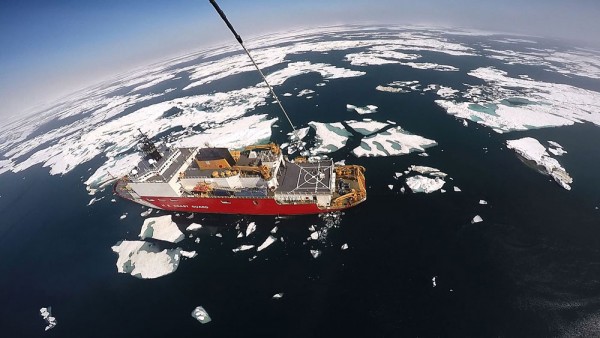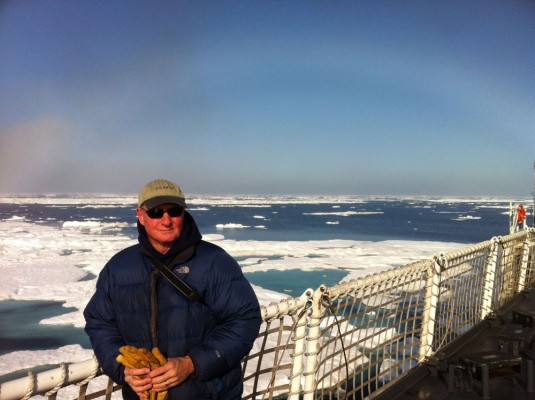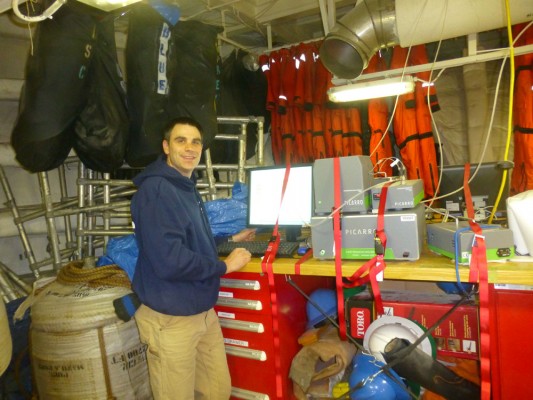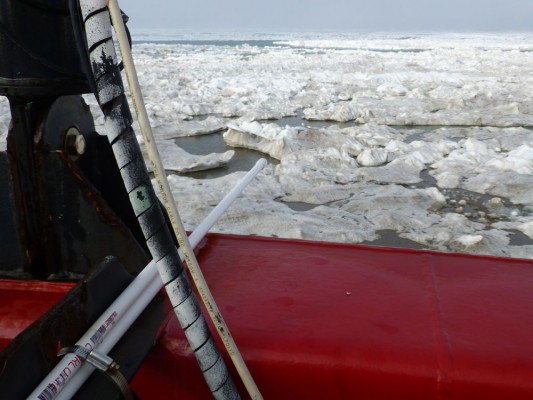"Sniffing out" change in the Arctic
by Kathleen McCoy |
[Watch a video aboard the USCGC Healy and listen to UAA scientists Jeff Welker and Eric Klein describe their work. This video, "Sniffing the Arctic," was created by and is featured on the Frontier Scientists website.]

USCGC Healy off the coast of Alaska as viewed from a webcam above the icebreaker. UAA sceintists Jeff Welker and Eric Klein were aboard, sampling air vapor isotopes to get a baseline picture of the region's chemistry. (U.S. Coast Guard image)
Say you're a ship captain navigating up Cook Inlet toward Anchorage, loaded to your portholes with-oh, strawberries, cars, Christmas presents, diesel fuel. About 80 percent of food and fuel consumed in Alaska arrives through this port. On a dark and stormy night, how can you know the path ahead is free of sea ice?
Or, you're the Coast Guard, responsible for ensuring foreign fishing vessels don't drift into U.S. waters. You can't be everywhere at once, so how do you monitor territory you can't even see?
Or, you've paid $20,000 for a berth aboard Crystal Serenity, the first luxury ship to travel the Northwest Passage next August-around Alaska and into the Beaufort Sea, through the Canadian Arctic Archipelago and on to Greenland. Do visions of the Titanic's last moments flash before your eyes?
Cameras and satellite imagery can help sea captains do some of this safety work, but camera batteries die and satellites present an image only once every 24 hours. A lot can happen in 24 hours.
Two UAA research scientists, Dr. Jeff Welker and Dr. Eric Klein, are working on a new idea. They've found a way to "sniff out" environmental clues that can reveal everything from the presence of sea ice to carbon lingering from a fuel spill to chlorophyll levels in an algae bloom.

Dr. Jeff Welker aboard the USCGC Healy. Dr. Jeff Welker, Fulbright Distinguished US Arctic Chair-Norway and professor of biology at UAA. (Photo courtesy of Jeff Welker / UAA)
"Sniff out" is certainly not the technical term, but the idea of a smart nose inhaling and analyzing the chemistry of the air describes their work. They analyze isotopes of water vapor; think of isotopes as tiny chemical fingerprints that carry the story of their source. Scientists read them to know if water vapor came from the north or the south, from over land or over sea, from melting sea ice or open water.
Sampling the environment this way is not new, but the capacity to collect and analyze high volumes of data-a sample every second around the clock-and then deliver results in real time, is new. In a typical week, their tools, with the assistance of computer codes, crunch more than a 100,000 lines of data and still manage to deliver a nice clean bar chart each evening.

Research scientists Eric Klein below deck on the USCGC Healy, installing a makeshift lab to capable of analyzing water vapor isotopes collected on deck. (Photo by Eric Klein / UAA)
Last July, the U.S. Coast Guard Cutter Healy carried the scientists and their chemistry and computer gear from Kodiak to Barrow and across the Arctic Ocean to Prudhoe Bay. Along the way, their "sniffer" collected and analyzed enough data to paint the chemical seascape for the whole region, a useful baseline for detecting future deviations.
They did this work for the Arctic Domain Awareness Center of Excellence (ADAC) located at UAA. The center launched in 2014 with a $17 million award from the Department of Homeland Security. With center funding, scientists like Welker and Klein work to develop tools than can support the Coast Guard's environmental safety and security mission.
The two researchers were confident they could measure the chemical seascape for Alaska's Arctic and sub-Arctic marine system. They based their hunch on studies funded by the National Science Foundation and pursued in 2013 at Toolik Lake, a field station in the foothills of the Brooks Range.
There, Klein sampled water vapor isotopes from one winter through the green up of a summer and into the start of the next snowy winter. Through isotope analyses he was able to determine the water's source, whether it had traveled from north or south, and if it came from evaporating sea ice or a mix of ice and open water. These results suggest water vapor isotopes may give a reliable picture of sea ice conditions.
Aboard the Healy, Welker and Klein situated an intake pipe on the bow of the ship. Plastic tubing carried air samples to a makeshift science lab below. On an icebreaker, the bow is not a serene spot. Their gear had to be lashed down for safety against ice-crunching vibrations and the up-and-down movement through waves.

Like a straw poking into the wind, this intake device channeled water vapor samples to analytic gear below deck to paint the chemistry landscape off Alaska's Arctic and sub-Arctic coast. (Photo by Eric Klein / UAA)
Their vision includes a streamlined laptop-sized version of the environmental "sniffer" aboard every Arctic-bound vessel. A real-time readout screen in the wheelhouse would supplement camera and satellite images the captain is already relying on. Are there dense ice conditions ahead? Check the camera, the satellite and the "sniffer."
They look forward to the day when many moored buoys deployed in remote locations can gather and analyze environmental carbon. Exhaust fumes from a cruise ship may linger for a few hours as it passes. But if the environmental carbon lingers for days-is the ship leaking fuel? Detecting an incident could prevent a disaster, says Welker.
Testing continues. Next summer, they hope to take their mobile lab off the coast of Santa Barbara, where oil slicks occur naturally. They want to find out if their equipment can detect lingering environmental carbon in many different situations: from just on top of the slick, to a quarter mile away, to even five miles away. Stay tuned.
A version of this story by Kathleen McCoy appeared in the Alaska Dispatch News on Sunday, Jan. 24, 2016.
 ""Sniffing out" change in the Arctic" is licensed under a Creative Commons Attribution-NonCommercial 4.0 International License.
""Sniffing out" change in the Arctic" is licensed under a Creative Commons Attribution-NonCommercial 4.0 International License.









